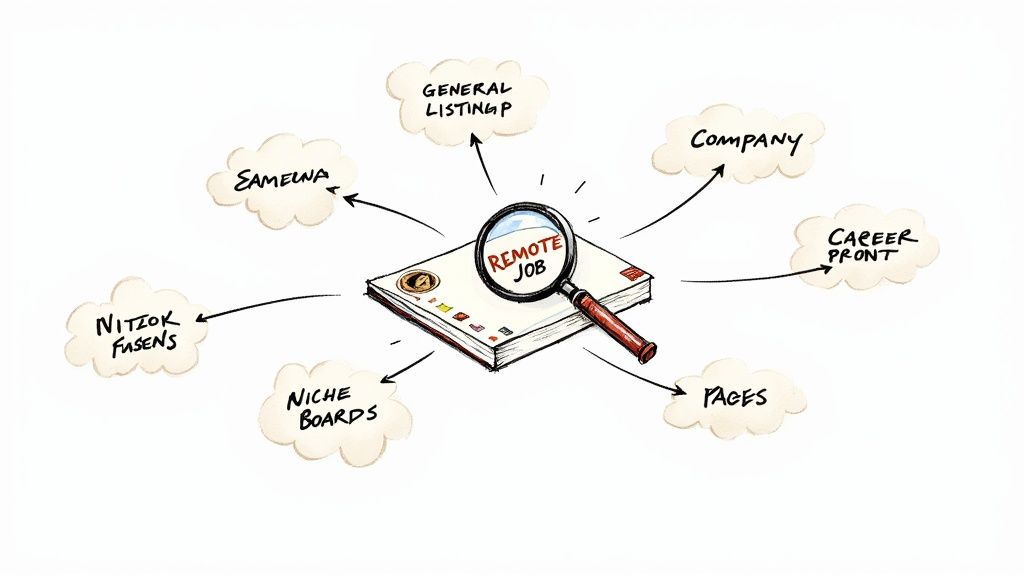How to Find Remote Jobs Online in Today's Market
Max
Before you even think about hitting “apply” on a remote job, you need to lay the groundwork. It’s all about building a professional brand that screams “remote-ready.” This isn’t just about listing your skills; it’s about crafting a digital presence that shows you’re disciplined, an excellent communicator, and someone who can thrive without a manager hovering over your shoulder.
Building Your Remote-Ready Professional Brand

Let’s be real: the competition for good remote jobs is fierce. A standard resume just won’t cut it anymore. You need a digital footprint—your LinkedIn, resume, and even your cover letter—that tells one cohesive story. That story should be: “I’m a self-starter who gets things done, no matter where my desk is.”
The shift to remote work has been massive. Back in 2020, only about 4% of jobs in the U.S. were remote. Fast forward to 2025, and that number has jumped to over 15% of all available positions. That’s a huge leap, and it means standing out is more important than ever. Your personal brand is your biggest advantage.
Optimize Your LinkedIn Profile For Remote Recruiters
Recruiters live on LinkedIn. It’s often the very first place they’ll look you up, so you need to make a great impression. Think of it as your personal marketing headquarters, not just a list of past jobs.
Here’s how to make it work for you:
- Get a Professional Headshot: A clear, friendly photo builds trust instantly. No concert selfies or blurry vacation pics.
- Write a Headline That Works Harder: Don’t just put your job title. Weave in keywords that remote recruiters are searching for, like “Remote,” “Distributed Teams,” or “Asynchronous Collaboration.” Instead of “Software Engineer,” try something like, “Senior Software Engineer | Building Scalable Systems for Remote-First Teams.”
- Show, Don’t Just Tell: Use your “About” and “Experience” sections to give real examples of how you’ve excelled in a remote environment. Mention the tools you’re a pro at, like Slack, Asana, or Jira. If you’re new to remote work, focus on transferable skills like disciplined time management and proactive communication.
A killer LinkedIn profile is like having a passive job search engine working for you 24⁄7, bringing the right recruiters straight to your digital doorstep. For a deep dive, check out our guide on https://remotefirstjobs.com/blog/how-to-optimize-linkedin-profile.
Craft a Resume That Speaks To Remote Hiring Managers
Your resume has two jobs: get past the Applicant Tracking Systems (ATS) and then grab the attention of a human being. For remote roles, that means ditching the boring list of duties and focusing on autonomy and results.
Quantify your achievements. Make them tangible. For instance, a project manager shouldn’t just say they “managed a team.”
Instead, try this: “Managed a fully distributed team of 8 across 5 time zones, delivering the project 15% under budget and two weeks ahead of schedule.”
That single sentence proves you can handle cross-cultural collaboration, manage finances responsibly, and execute a project independently. Those are the exact traits remote hiring managers are desperate to find. In this market, your digital reputation is everything. Learning how to build an online presence that gets results is a non-negotiable step to amplify your personal brand.
Finding Quality Remote Jobs Without the Noise

Alright, now that your professional brand is sharp and ready, let’s get into the real meat of the hunt: how to find remote jobs online. The internet is an absolute ocean of job postings, but frankly, most of them aren’t worth your time.
One of the quickest ways to burn out is by wasting hours scrolling through generic job boards flooded with outdated listings, scams, or “remote” jobs that are actually hybrid.
Your strategy needs to be surgical, not a scattergun blast. It’s all about focusing your energy on the platforms and places where high-quality remote opportunities are the norm, not the exception. A smart search combines curated job boards, a bit of direct company stalking, and maybe even some niche freelance platforms.
Go Beyond the General Job Boards
Big-name platforms are a starting point, but they are incredibly noisy. A simple search for “remote” can pull up thousands of roles, and a huge chunk of them are mislabeled or just plain low-quality. This is where specialized, remote-first job boards become your secret weapon.
These sites do the heavy lifting for you. They vet the companies and make sure the roles are genuinely remote, often from businesses that actually know how to run a distributed team.
- Remote-First Job Boards: Platforms like Remote First Jobs or We Work Remotely are built for this. They cut through the noise, eliminating the spam and “hybrid-in-disguise” roles.
- Industry-Specific Boards: If you’re in a specific niche like tech, design, or marketing, these boards connect you directly with companies desperate for your exact skillset.
- Top-Tier Freelance Marketplaces: For contract gigs, platforms like Toptal connect elite talent with serious projects. It’s another fantastic route to high-paying remote work.
The shift to remote work isn’t a trend; it’s a permanent fixture. An estimated 32.6 million Americans—roughly 22% of the workforce—are now working remotely. Most of them found these roles using the exact mix of strategies we’re talking about: specialized boards, direct applications, and networking.
Finding the right platform is half the battle. To help you zero in on the best places to look, here’s a quick comparison of some of the top spots.
Top Platforms to Find Remote Jobs Online
| Platform | Best For | Key Features | Example Job Types |
|---|---|---|---|
| Remote First Jobs | Curated, high-quality remote roles across various industries. | Hand-picked listings, clear company profiles, no spam or hybrid roles. | Customer Support Specialist, Software Engineer, Digital Marketer |
| Networking and discovering roles at large, established companies. | Massive user base, detailed company pages, direct messaging with recruiters. | Project Manager, Business Analyst, Sales Director | |
| We Work Remotely | Tech-focused roles from companies with strong remote cultures. | One of the oldest remote boards, trusted by major tech companies. | Full-Stack Developer, UX/UI Designer, Product Manager |
| FlexJobs | Vetted flexible and remote jobs, including part-time and freelance. | Subscription-based, scam-free guarantee, skills testing. | Virtual Assistant, Writer, Accountant |
| Upwork | Freelance projects for independent contractors and agencies. | Escrow protection, client reviews, project-based and hourly work. | Graphic Designer, SEO Consultant, Mobile App Developer |
This table gives you a starting point, but don’t be afraid to explore. The key is to find the platforms where your target companies and roles are most active.
Target Companies Directly
Here’s an underrated tactic: go straight to the source. Many of the best remote jobs are never even posted on public boards. They’re tucked away on a company’s own “Careers” or “Join Us” page.
This approach takes a little more legwork, but the payoff can be huge. You’re up against far less competition, and it shows you have a genuine interest in their mission—not just any old job.
Identify True Remote-First Businesses
So, how can you tell if a company actually gets remote work or is just grudgingly allowing it? Look for the clues.
Check their website and job descriptions for things like a home office stipend, flexible work hours, or co-working space memberships. Do they talk about their distributed team or their favorite tools for asynchronous communication? These aren’t just perks; they’re signs of a mature remote-first culture. That’s the environment where you’ll thrive.
For a deeper comparison of your options, check out our guide on the best remote job websites to really fine-tune your search. This focused strategy is how you stop wasting time and start finding real opportunities.
Making Your Applications Actually Get Noticed
Finding a promising job post is a great start, but it’s just that—a start. With hundreds of applicants often vying for the same role, your application needs more than luck to actually land on a hiring manager’s screen. To really succeed in finding remote jobs online, you have to shift your mindset from being a passive applicant to a strategic candidate.
This isn’t about applying to more jobs; it’s about making each application count. It means using smarter techniques to uncover those hidden-gem opportunities and crafting an application so perfectly aligned with the role that it becomes impossible for them to ignore. This targeted approach is what separates the people who get interviews from everyone else lost in the digital shuffle.
Uncover Hidden Gems with Smart Search Tactics
Most people just type a job title into a search bar and hope for the best. There’s a much better way. By using a few simple commands, known as Boolean operators, you can refine your search and find roles that others completely miss. Think of them as your secret search engine superpower.
These operators let you tell the job board exactly what you want—and just as importantly, what you don’t.
- Use “AND” to combine skills. Searching for “Product Manager” AND “SaaS” makes sure both terms appear in the listing, filtering out all the irrelevant product roles.
- Use “OR” for flexibility. A search like “Content Marketer” OR “Content Strategist” broadens your results to include similar titles you might have overlooked.
- Use “NOT” to eliminate noise. Tired of seeing entry-level positions? Try “Marketing Manager” NOT “Assistant” NOT “Intern” to instantly clean up your feed.
- Use quotation marks (” “) for exact phrases. Searching for “Senior Software Engineer” will only show you roles with that precise title, cutting out the generic “Software Engineer” or “Senior Engineer” listings.
By combining these, you can build some seriously powerful search queries. For example: (“Project Manager” OR “Program Manager”) AND “Remote” NOT “Healthcare”. That simple string instantly narrows your focus to relevant, high-quality opportunities.
Tailor Your Resume to Beat the Bots
Once you’ve found the perfect role, your next hurdle is the Applicant Tracking System (ATS). These are the automated systems that scan every resume for specific keywords from the job description before a human ever sees them. If your resume doesn’t have the right words, it gets tossed out automatically.
This is exactly why a one-size-fits-all resume is a recipe for failure. For every single application, you need to customize your resume to mirror the language in the job post. Pull out key skills and phrases—like “asynchronous communication,” “project management software,” or “cross-functional collaboration”—and weave them naturally into your experience section. This one step can dramatically increase your chances of getting noticed.
For more detailed guidance, our complete walkthrough on creating a resume for remote jobs offers specific examples and templates to get you started.
Network Without Being Annoying
Finally, don’t just hit “apply” and wait. A little proactive networking on LinkedIn can be a total game-changer. Find the hiring manager or someone on the team at the company you’re targeting.
Send a brief, personalized connection request. Please, avoid the generic messages. Instead, try something specific that shows you’ve done your homework:
“Hi [Name], I just applied for the [Job Title] role. I was really impressed by [Company]’s recent project on [mention something specific] and believe my experience in [your relevant skill] could be a great asset. I’d love to connect.”
This shows genuine interest and initiative. It puts a human face to your application and transforms you from just another name on a list into a proactive professional worth talking to.
Navigating the Virtual Interview with Confidence

You did it. You navigated the applications, fine-tuned your resume, and landed the interview. Big congrats. Now it’s time to show them you’re the one for the job, and in the remote world, that means absolutely nailing the virtual interview.
This isn’t just about answering questions over a webcam. It’s your chance to prove you have the communication skills and technical awareness to be a rockstar on a distributed team.
First impressions in a video call are incredibly powerful—and unforgiving. A flickering light, a choppy internet connection, or a cluttered background can immediately distract from your experience. Your mission is to make the technology disappear so the only thing they remember is you.
Your Pre-Interview Tech And Environment Check
Before you even start practicing your answers, get your setup sorted. Just a few minutes of prep can save you from those cringe-worthy “can you hear me now?” moments that totally kill an interview’s momentum. A full tech run-through the day before isn’t just a suggestion; it’s essential.
Here’s a quick-and-dirty checklist to get you started:
- Check Your Lighting: Face a window or another light source. Whatever you do, don’t sit with it behind you—you’ll end up as a silhouette. A simple ring light is a cheap and effective fix if natural light is hard to come by.
- Test Your Audio: Please, use headphones with a built-in microphone. Your laptop’s mic is designed to pick up every echo and bit of background noise, which makes you sound like you’re calling from a cave.
- Stabilize Your Internet: If you can, plug directly into your router with an Ethernet cable. It’s the most reliable option. If you’re stuck on Wi-Fi, make sure no one else in the house is streaming movies or online gaming during your call.
- Curate Your Background: A clean, neutral background is always the safest bet. A tidy bookshelf or a simple, uncluttered wall works perfectly. I’d steer clear of virtual backgrounds; they can glitch out and look pretty unprofessional.
Think of your interview space as an extension of your professional brand. A clean, quiet, and well-lit environment subconsciously tells the interviewer that you’re organized, serious, and prepared for remote work.
Answering Remote-Specific Questions
When you find remote jobs online, you’re going to get hit with questions designed to see if you can handle working on your own. Hiring managers need to feel confident you can manage your time, communicate clearly without being in the same room, and figure things out independently.
Get ready for questions like:
- “How do you handle collaboration across different time zones?”
- “Tell me about a time you had to solve a problem without direct supervision.”
- “What strategies do you use to stay motivated and avoid distractions while working from home?”
Your answers need to be packed with specific examples. When they ask about time zones, mention the tools you use. For instance, you could explain how you rely on a meeting planner for time zones to schedule calls without the guesswork, showing you’re already thinking like a pro.
For more on this, we’ve put together a full guide with more remote interview tips.
And don’t forget the follow-up. A prompt, thoughtful thank-you email within 24 hours is non-negotiable. Reiterate your interest, mention something specific you enjoyed about the conversation, and give one final reminder of why you’re a great fit. It’s a small touch that leaves a huge, positive impression.
How to Spot Scams and Evaluate Real Offers

As you start finding exciting remote jobs online, your ability to tell a legitimate opportunity from a well-disguised scam is probably your most critical skill. The internet’s anonymity makes it a perfect playground for fraudsters, and unfortunately, remote job seekers are a prime target.
These scams are designed to prey on your excitement and sense of urgency. Their goal? To get your personal information or, even worse, your money. But with a bit of vigilance, you can learn to spot the red flags from a mile away and keep yourself safe.
Telltale Signs of a Remote Job Scam
Scammers tend to follow a predictable script. They’ll create a sense of urgency and promise unbelievable rewards for very little effort. If a job posting or an email you receive has any of these warning signs, your guard should immediately go up.
- Vague Job Descriptions: If the role’s duties are fuzzy and packed with generic corporate buzzwords but the salary is surprisingly high, be wary. Real jobs come with specific, detailed responsibilities.
- Requests for Money or Personal Data: This is a huge one. Legitimate employers will never ask you to pay for training, equipment, or background checks. They also won’t ask for your Social Security number or bank details before a formal, signed offer is in place.
- Unprofessional Communication: Keep an eye out for emails coming from personal accounts (like Gmail or Yahoo) instead of a proper corporate domain. Poor grammar, typos, and an overly casual tone are also major red flags.
- Instant Job Offers: If you’re offered a job after a quick text-based chat or, even worse, with no interview at all, it’s almost certainly a scam. Real companies have a proper, multi-stage hiring process.
To make it easier, here’s a quick-reference table to help you identify and steer clear of potential online job scams.
Red Flags in Remote Job Postings
| Red Flag | Why It’s a Concern | What to Do |
|---|---|---|
| Too-Good-To-Be-True Salary | Scammers lure you in with unrealistic pay for a simple role. | Compare the salary to industry averages on sites like Glassdoor. If it’s wildly inflated, be suspicious. |
| Requests for Payment | A real employer invests in you; they don’t ask you to pay them. | Immediately cease communication. Never send money, gift cards, or crypto for a job opportunity. |
| Interviews via Text/Chat Only | This avoids face-to-face interaction, making it easier to hide a fake identity. | Insist on a video call with the hiring manager. If they refuse, it’s a scam. |
| Pressure to Act Immediately | Urgency is a tactic to prevent you from thinking clearly and doing research. | Take your time. A legitimate company will understand you need time to consider an offer. |
| No Online Presence | If the company has no professional website or a flimsy LinkedIn page, it likely doesn’t exist. | Do a quick search. If you can’t find them, or their site looks fake, walk away. |
Ultimately, always trust your gut. If an offer just feels off or too good to be true, it probably is. A real employer will respect your questions and have no problem providing clear, verifiable information about the company and the role.
For a deeper dive, our complete guide on finding legitimate work-from-home jobs offers a comprehensive checklist to help you stay safe out there.
How to Verify a Company and an Offer
Before you get too invested in an application or interview process, do a little detective work. A few minutes of research can save you hours of wasted time and potential heartbreak.
Start by searching for the company on LinkedIn and checking its official website. Look for a professional online presence, real employee profiles, and a clear “Careers” or “Jobs” page. Always try to cross-reference the job posting on the company’s own site—if you can’t find it there, that’s a serious problem.
Evaluating a Genuine Job Offer
Congratulations! You’ve navigated the search, dodged the scams, and received a real offer. Now the final evaluation begins. This is about way more than just the salary; it’s about looking at the whole picture to make sure the role is the right fit for your career and your life.
Look beyond the base pay and consider the entire compensation package.
- Benefits: Does the company offer health insurance, retirement plans, or maybe a home office stipend? These perks have significant financial value that adds to your total compensation.
- Work Hours and Flexibility: Make sure you clarify the expectations around core working hours, especially if the team is spread across different time zones. Is there true flexibility, or are you expected to be online from 9-to-5 on the dot?
- Company Culture: Try to get a real feel for the team dynamic. During the interviews, ask pointed questions about communication styles, the tools they use for collaboration, and what opportunities for growth look like.
A great remote job is a partnership. By carefully vetting opportunities and evaluating offers holistically, you set yourself up for long-term success and happiness in your new role.
Of course. Here is the rewritten section, crafted to sound like it was written by an experienced human expert.
Questions Everyone Asks About Finding Remote Work
Jumping into the remote job market can feel like trying to navigate a new country without a map. It’s completely normal to have a ton of questions. Getting them answered is the first step toward building a search strategy that actually works.
Let’s tackle some of the most common things people worry about when they start looking for a remote job.
One of the biggest anxieties I hear is, “Do I even stand a chance without remote experience on my resume?” While having it is a nice bonus, it’s rarely the deal-breaker you think it is.
What hiring managers really care about are your remote-ready skills.
They want to see proof that you can be productive and reliable without someone looking over your shoulder. Think back on your past roles and find examples of when you’ve shown:
- Self-discipline and time management to pull off a complicated project.
- Proactive communication to keep your team updated without being asked.
- Independent problem-solving when you couldn’t just walk over to your manager’s desk for an answer.
Weaving concrete examples of these skills into your resume is way more convincing than just saying you’ve worked from home before.
Do I Need a Ton of Special Equipment?
This is another big one. Do you need to drop a grand on a high-tech home office before you even apply? Nope. Most legitimate remote companies will ship you the essentials, like a company laptop.
That said, your end of the bargain is a reliable setup. This means you need a stable, high-speed internet connection and a quiet space where you can take calls without your dog barking in the background. You don’t need the fanciest gear, but you absolutely need a professional, distraction-free environment to get your work done.
The most important “equipment” you can have is a mindset geared for autonomy and clear communication. The physical tools are secondary to your ability to manage your own workflow and collaborate effectively from a distance.
How Can I Possibly Stand Out From the Crowd?
When a single remote job gets hundreds, sometimes thousands, of applicants, just hitting “apply” feels like sending your resume into a black hole. This is where you have to get a little creative.
First, personalization is everything. Always, always tailor your resume and cover letter to the job description. Use their language and shine a spotlight on the exact skills they’re asking for.
But don’t stop there. A little networking can be a game-changer. After you apply, hop on LinkedIn and find the hiring manager or someone on the team. Send a short, professional message. Something simple that shows your genuine interest in what they’re building can pull your application out of the pile and make you a person worth remembering. That extra step is often what gets you the interview.
Ready to cut through the noise and find a role you’ll love? Remote First Jobs has thousands of verified, spam-free listings from companies that get remote work right. Start your focused and effective search today at https://remotefirstjobs.com.


